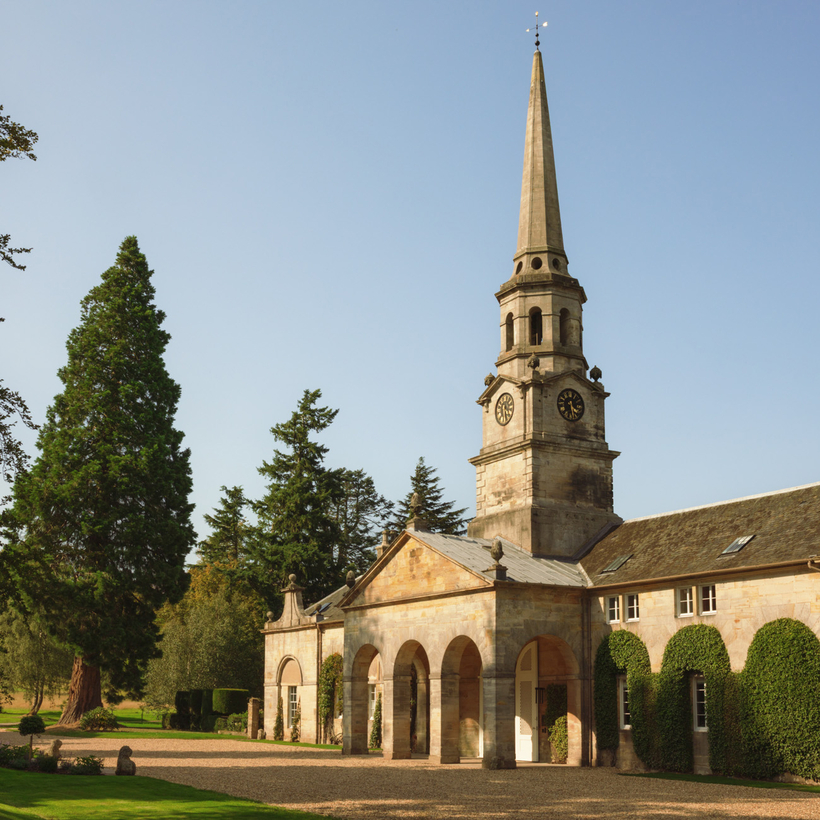In 1899, the “old” Penicuik House went up in smoke. Today, 100 yards away, a photograph on a wall in the “new” Penicuik House depicts ladies taking tea on the lawn, surrounded by their belongings as flames lick the roof of what was once the finest Palladian manor in Scotland.
“It burned for two weeks,” explains Ed Clerk, the 14th generation to steward Penicuik and its 7,500 acres south of Edinburgh at the foot of the Pentland Hills. “But in a twist of fate, it kept the estate in the family, as it was up for sale at the time because they’d essentially run out of money.”

After the fire, the Clerks moved into the stable block, which became known as Penicuik House. This was no common-as-muck stable, though—instead, it was another Palladian design with an elegant clock spire and a domed dovecote modeled on a Roman temple, all set around a courtyard.
Inside, the family re-purposed window shutters as wood paneling, and salvaged ornate fire surrounds and door architraves. They also re-installed belongings, gathered over centuries of collecting and grand tours: Tibetan gun racks, 500-year-old swords, rare books of drawings by Scottish architect Robert Adam, marble statues of goddesses, and hundreds of paintings.

The younger son of the current baronet, 39-year-old Clerk traded fund management to take on the ancestral seat in 2019. “I’ve always been the one in the family with lots of annoying ideas,” he says of his thoughtful, ambitious plan to regenerate the estate.
It includes adopting sustainable farming and forestry practices, restoring both nature and heritage, and adding hospitality to the mix. Porter’s lodges and groundkeeper’s cottages have already been turned into five handsome vacation homes. More cottages and a handful of tree houses will follow, while Penicuik House, where Clerk grew up, has been freshly restored for grander gatherings.

The family room where he held parties as a teenager has become the grandest of the 16 bedrooms: a vaulted, butter-yellow-painted corner of the ground floor with its own garden. Highland cows, grazing on the hillside, can be glimpsed from the window.
The other bedrooms are all different, all with their own charm: one wallpapered like a romantic forest, another with a canopied bed. Alongside are sitting rooms and kitchens, a banquet-worthy dining room, a cozy screening room, and a boot room stocked with Wellington boots and waterproof clothing.

Portraits and other treasures are everywhere; the walls are lined with stories. In the entrance hall, guests are welcomed under the watchful, oil-painted eye of Sir John Clerk, second baronet, also known as “the Baron.” The Baron and his son James were 18th-century luminaries. Among their polymath achievements were creating Scotland’s first “designed landscape” (grounds created expressly for artistic effect) at Penicuik as well as building the Palladian house and stables.
The Baron also planted around 600,000 trees across the estate, and millions more have been added since then. One of the many beauties of Penicuik is that you can be deep in those woods just half an hour after walking out of Edinburgh Airport.
There are more than 12 miles of hiking and biking trails that cut through the landscape. Hardy souls can swim in one of the ponds; the local curling club has competitions on another when it freezes.

Strike out from the front gate and walk up Scald Law, the highest of the bracken-covered Pentland Hills. It’s a solid climb, worthy of tea and cake in the drawing room afterward. For all the grand backstory, the most impressive thing about Penicuik House is that it still has the soul of a much-loved family home—albeit one where the patriarch traded in Rembrandts.
The writer was a guest of Penicuik Estate, where rental of Penicuik House (which can accommodate 32 guests) begins at $13,305 per night, including breakfast. Cottages on the estate (for groups of two to eight) begin at $300 per night
Fiona Kerr is a former features director at Condé Nast Traveller (U.K.) and now contributes to the Financial Times, The Guardian, and The Telegraph

